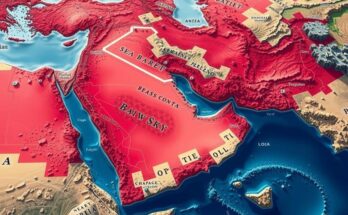The year 2024 was detrimental for the Iranian regime following the fall of Bashar al-Assad, marked by significant military and political setbacks across the Middle East. Key figures in Iranian influence were targeted, leading to economic decline, particularly with the rial becoming the lowest valued currency globally. The ascent of Donald Trump further complicated Iran’s geopolitical prospects, triggering concerns over renewed sanctions and losses in the Axis of Resistance.
The year 2024 marked a significant downturn for the Iranian regime, particularly following the decline of Syrian President Bashar al-Assad. Strikes against Iran in Gaza, Lebanon, and Syria further weakened its influence within the so-called Axis of Resistance. Amidst deteriorating economic conditions, characterized by its currency becoming the lowest valued globally, Iran faced escalating challenges and geopolitical setbacks. Below is a retrospective analysis of the setbacks experienced by Ayatollah Ali Khamenei’s administration.
In April, a retaliatory strike against Israel failed to yield any significant impact, undermining Iranian capability after Israel bombed its embassy in Syria. A coordinated defensive response, involving over 300 Iranian drones and missiles, was largely thwarted with assistance from the U.S. military and its allies. The situation worsened in May with the death of former President Ebrahim Raisi in a helicopter crash, which Iran attributed to adverse weather conditions, thereby eliminating a potential successor for Khamenei.
July saw another severe blow when Israel successfully eliminated Hamas leader Ismail Haniyeh during his visit in an intelligence operation, undermining Iranian ties with the militant group. The pattern of losses continued into October, culminating in the death of Hamas chief Yahya Sinwar, a figure crucial in orchestrating attacks against Israel, thus diminishing hope for Iranian influence through Hamas.
The advent of November brought the surprising election of Donald Trump, further impacting Iran’s economy, as the rial reached an unprecedented low amid fears of renewed American sanctions. These would likely re-establish the “maximum pressure” approach that had previously constrained Iran’s financial capacity.
By the end of the year, Iran faced additional challenges as its proxy Hezbollah negotiated a ceasefire with Israel after escalating hostilities while simultaneously witnessing the fall of the Assad regime in December. This loss severed a crucial supply route for arms to Hezbollah, signifying a pronounced decline in Iran’s strength in the region. Syria’s governance shifted to Sunni leadership unfavorable to Iran’s Shiite theocracy, markedly altering the strategic landscape.
The context surrounding the Iranian regime’s losses in 2024 highlights the precarious nature of its geopolitical standing, particularly as it relates to events in surrounding countries like Syria and Lebanon. Historically, Iran has positioned itself as a significant player in the Middle East through alliances with militant groups and its influence over neighboring states. The upheaval following Assad’s fall signifies a transformation in this dynamic, born from a complex interplay of military aggression and political shifts amidst internal challenges.
In conclusion, the year 2024 proved to be disastrous for the Iranian regime, characterized by geopolitical defeats, the collapse of critical alliances, and dire economic straits. The cascading failures, especially within Syria and with key proxy groups, demonstrate the fragility of Iran’s strategic posture as it contends with both regional adversaries and changing international landscapes. The implications of such struggles will likely resonate well into future years, challenging Iran’s ambitions and security.
Original Source: www.foxnews.com




